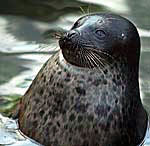Ringed Seal
Ringed Seal Sounds (Phoca hispida)
Description

Baltic ringed seal. Courtesy of Anna Roos, Swedish Museum of Natural History
Ringed seals have a circumpolar distribution in the northern hemisphere and can be found associated with sea ice throughout the Arctic Ocean and in seasonally ice-covered subarctic seas. These small seals use sea ice as a platform to haul out and rest, as well as to give birth and nurse their pups. They can maintain breathing holes in sea ice that is greater than 2 m (6 ft) thick using the heavy claws on their foreflippers. As snow accumulates during the winter, ringed seals carve out lairs in snow drifts overlying some of their breathing holes, allowing them to haul out of the water but remain insulated from the cold Arctic air (as well as hidden from the view of predators). They are preyed upon by arctic foxes and polar bears. Although their diet varies seasonally and regionally, ringed seals most commonly prey upon Arctic cod. Ringed seals earned their name from the light gray to white colored rings on their dark gray colored sides and backs. The underside of ringed seals is silvery. Like other Arctic seals, their pups are born with long white fur called lanugo. The average length of adult ringed seals is 1.2-1.3 m (approximately 4 ft).Ringed seals produce simple barks, yelps, and clicks in the frequency range of 0.4-16 kHz. These underwater vocalizations are heard year round, so it is not thought that they are associated with any reproductive behavior. It is not known how ringed seals find food or their breathing holes under the ice during the winter darkness.
Additional Resources
- Scripps Institution of Oceanography, Voices in the Sea